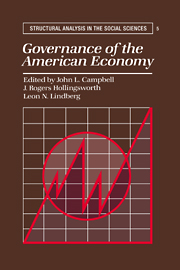Book contents
- Frontmatter
- Contents
- List of figures
- List of tables
- List of contributors
- Preface
- I Conceptual and historical foundations
- II Empirical studies of governance transformations in the United States
- 3 Transformations in the governance of the American telecommunications industry
- 4 Contradictions of governance in the nuclear energy sector
- 5 The statist evolution of rail governance in the United States, 1830–1986
- 6 Governance of the steel industry: What caused the disintegration of the oligopoly?
- 7 Governance of the automobile industry: The transformation of labor and supplier relations
- 8 The dairy industry: From yeomanry to the institutionalization of multilateral governance
- 9 Economic governance and the American meatpacking industry
- 10 The invisible hand in healthcare: the rise of financial markets in the U.S. hospital industry
- III Theoretical evaluation of the empirical cases
- References
- Index
6 - Governance of the steel industry: What caused the disintegration of the oligopoly?
Published online by Cambridge University Press: 21 March 2010
- Frontmatter
- Contents
- List of figures
- List of tables
- List of contributors
- Preface
- I Conceptual and historical foundations
- II Empirical studies of governance transformations in the United States
- 3 Transformations in the governance of the American telecommunications industry
- 4 Contradictions of governance in the nuclear energy sector
- 5 The statist evolution of rail governance in the United States, 1830–1986
- 6 Governance of the steel industry: What caused the disintegration of the oligopoly?
- 7 Governance of the automobile industry: The transformation of labor and supplier relations
- 8 The dairy industry: From yeomanry to the institutionalization of multilateral governance
- 9 Economic governance and the American meatpacking industry
- 10 The invisible hand in healthcare: the rise of financial markets in the U.S. hospital industry
- III Theoretical evaluation of the empirical cases
- References
- Index
Summary
For generations, the U.S. steel industry has been a prototypical oligopoly. It has been the subject of innumerable antitrust investigations by Congress, the courts, and economists. Its leaders have taken pride in having overcome the “chaotic” nature of competitive markets, thus maintaining remarkably stable steel prices. In contrast, we now read in the trade press of price rebates that exceed 25% of the list price. Advocates of protectionism blame imports for the industry's loss of price-setting power.
Students of the U.S. steel industry show us that there are now in fact two steel industries, one that tries to cling to oligopolistic practices, and one that is highly competitive (Barnett and Schorsch 1983; Acs 1984; Barnett and Crandall 1986). The latter, the so-called minimills sector, is credited with having captured more than 20% of the domestic steel market, and this sector is expected to continue to thrive. In the future, it is believed, the minimills will alter the structure of the U.S. steel industry permanently.
The deterioration in the competitive position of American integrated steel makers and the subsequent disintegration of the oligopoly is frequently attributed to the oligopoly structure itself (e.g., Borrus 1982; Barnett and Schorsch 1983; Acs 1984). This popular thesis often ascribes the crisis in the U.S. integrated steel industry to subjective factors, such as management's refusal to abandon its oligopolistic behavior. Management, of course, rejects this contention and blames factors outside its control, such as slow market growth, U.S. and foreign government steel policies, and labor, among others (American Iron and Steel Institute 1980).
- Type
- Chapter
- Information
- Governance of the American Economy , pp. 182 - 208Publisher: Cambridge University PressPrint publication year: 1991



